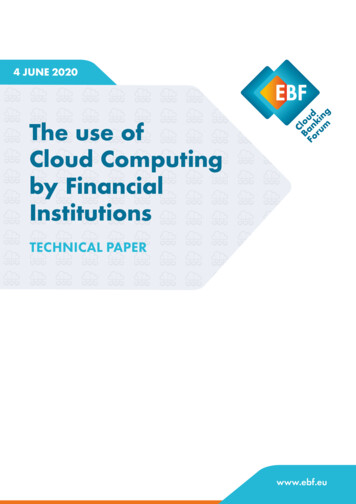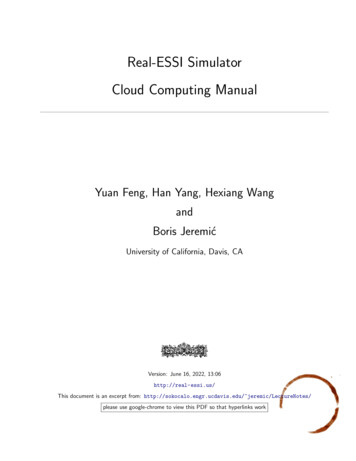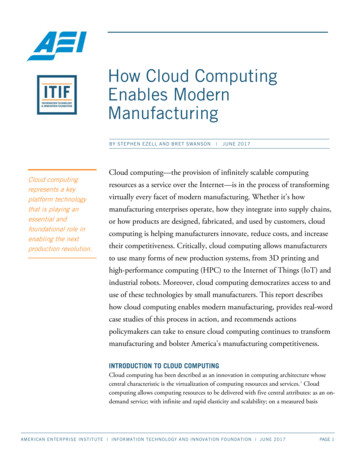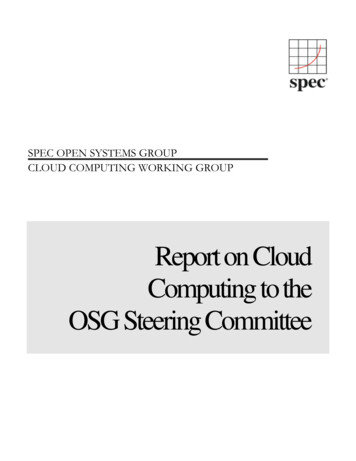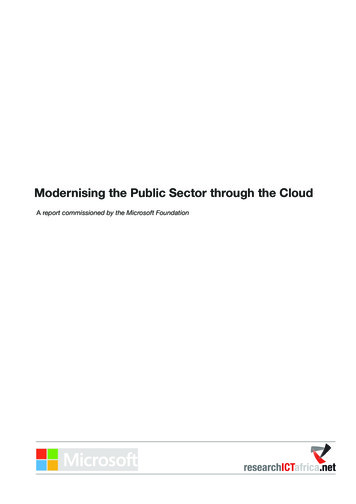
Transcription
Modernising the Public Sector through the CloudA report commissioned by the Microsoft Foundation
2 Cloud Policy for the Public SectorACKOWLEDGEMENTSWith a considerable amount of technical awareness around the benefits of the adoption of cloudservices and applications to enterprise development generally, this report was commission by theMicrosoft Foundation and the South African Microsoft Office specifically to support decisionmaking for the development of a cloud policy, strategy and implementation in South Africa.Theresearch and interviews were conducted during 2016 and the authors, Dr Alison Gillwald andMpho Moyo, thank those interviewed from the public and private sector who contributed theirtime and knowledge to the paper, and hopefully to enhancing public service delivery in SouthAfrica. We also thank Heba Ramzy and Siyabonga Madyibi, from Microsoft for enabling researchaccess to Microsoft workshops, research and expertise on the cloud.Enquiries:Research ICT Africa409 Old Castle Brewery6 Beach RoadWoodstock 7925South AfricaTel: 021-4476332Fax:021 4479529www.researchICTafrica.net
3 Cloud Policy for the Public SectorEXECUTIVE SUMMARYInformation Communication Technology (ICT) is recognised as a key enabler of economic growthand development in South Africa. Progress towards modernising ICT in the public sector hasbeen slow and the government lags the private sector in terms of ICT adoption, including cloudcomputing. The ICT policy environment remains fragmented and ICT adoption in the public sectorhas been hampered by protracted policy processes and stalled decision-making and generallythere is a gap between what is stipulated in policy documents and implementation of thesepolicies and guidelines in practice.Negative macro-economic conditions have necessitated the need for the public sector to look forways to meet the increasing demands for service delivery within a limited budget. Cloudcomputing, which falls under the domain of ICT is viewed as having the potential to promotegreater efficiencies, integration, coordination and cost savings within the public sector. Cloudcomputing is also expected to enable the government to meet the objectives set out in theNational Development Plan and SA Connect, including achieving better coordination betweengovernment departments and enabling the delivery of e-government services, yet the use theseservices have been limited within the public sector.The absence of policy guidelines and a champion for cloud computing services is limiting the useof cloud computing services within the public sector. Other barriers include issues around dataclassification, data protection, security and residency, availability and cost of underlyingbroadband infrastructure, and lack of implementation of uniform open standards.Generally, there is a “siloed” and fragmented approach to ICT usage, including cloud computing,within the public sector. As a result, many government departments remain disparate and are notinteroperable. Most cloud computing deployments are ad hoc and uneven across differentgovernment departments as there is no centralised and coordinated approach to ICT deploymentacross all spheres of government, which could be addressed by developing a national centrallycoordinated cloud strategy.There are wider policies, regulation and legislation that affect the implementation of cloudcomputing services in government, including e-government legislation, information protectionregimes, information storage and classification measures and privacy protection that can beexpanded to cover cloud computing services.
4 Cloud Policy for the Public SectorTable of contentsACKOWLEDGEMENTS2EXECUTIVE SUMMARY3ABBREVIATIONS61. Background82.93.4.5.6.South Africa’s Macro-Economic EnvironmentCloud Computing3.1. Definitions3.2. Types of cloud computing3.3. Cloud services3.3.1. Infrastructure as a Service (IaaS)3.3.2. Software as a Service (SaaS)3.3.3. Platform as a Service (PaaS)Cloud in the ICT ecosystemSignificance of the Cloud5.1. Value of cloud computing for the public sector5.1.1. The United Kingdom5.1.2. New Zealand5.1.3. South Korea5.2 Institutional arrangements and leadership5.3 Fragmentation of mandate in government5.4 SynthesisThe Benefits of Cloud Computing991010101111111213141517181920227.The South African Case7.1. Cloud market in South Africa7.1.1. Drivers7.1.2. Barriers7.1.3. Private sector view of public sector cloud readiness7.2. Status of cloud use by public sector in South Africa7.2.1. Skills shortages in public sector7.2.2. Absence of cloud computing policy for the public sector7.2.3. Inconsistencies in the approach to cloud computing7.3. Cloud mainly for noncritical processes7.4. Assessment of public sector cloud computing awareness and deployment7.4.1. City of Johannesburg (CoJ)7.4.2. Government Pension Administration Agency (GPAA)7.5. Identification of barriers to adoption of cloud computing for the public sector7.5.1. Technical barriers7.5.2. Managerial and organisational barriers7.5.3. Policy challenges23232325252629292929303030313132338.SA Cloud readiness8.1. Vision, policy framework and institutional arrangements3434
5 Cloud Policy for the Public Sector8.2. National Development Plan and Presidential Infrastructure Coordinating Council348.2.1. SA Connect implementation358.2.2. ICT policy review368.3. Applicable policy, regulation and legislation to regulate activities in the cloud in the SouthAfrican government378.3.1. State Information Technology Agency (SITA)388.3.2. Storage and management of records by South African governments388.4. Information Protection Regime388.4.1. The Electronic Communications and Transactions Act398.4.2. Electronic Communications Act 36 as amended by Act 1 2014408.5. Protection of Personal Information Act 4419.Cloud First Policy for South African Public Sector9.1. Open data policy424210. E-gov, interoperability and standards10.1. Minimum Interoperability Standards for government information systems10.1.1 Capacity10.1.2 Aims10.1.3 Interoperability444546464611. Findings/Conclusions11.1. Institutional arrangements and leadership11.2. Fragmentation of mandate in government11.3. Lack of a coherent public policy4747474812. Recommendations4812.1. Position cloud as a solution to skills shortages4812.2. Improve availability and quality of broadband infrastructure4812.3. Develop a cloud computing policy framework4812.4. Establish a designated champion for cloud computing services4912.5. Implement and enforce open and interoperable standards to public sector procurement 4912.6. Adopt best practices to develop security framework for cloud services4912.7. Expand data classification guidelines to include cloud computing5012.8. Provide guidance for cloud vendor certification and compliance5013.SUMMARY TABLE OF RECOMMENDATIONS/ACTIONS5114.List of interviewees53
6 Cloud Policy for the Public SectorABBREVIATIONSBBBEEBroad-Based Black Economic EmpowermentBRICSBrazil, Russia, India, China and South Africa (five major national emerging countries).CAPEXCapital ExpenditureCIOChief Information OfficerCoJCity of JohannesburgDCSDepartment of Correctional ServicesDHADepartment of Home AffairsDHSDepartment of Human SettlementsDOJDepartment of JusticeDPSADepartment of Public Service and AdministrationDSDDepartment of Social DevelopmentDTPSDepartment of Telecommunications and Postal ServicesECAElectronic Communication ActECTAElectronic Communications and Transactions ActE-GOVElectronic governmentFSBFinancial Services BoardG-CloudGovernment Cloud ComputingGCIOGovernment Chief Information OfficerGDPGross Domestic ProductGDSGovernment Digital ServiceGITOCGovernment Information Technology CouncilGPAAGovernment Pension Administration AgencyIaaSInfrastructure as a ServiceICTnformation and Communications Technology
7 Cloud Policy for the Public SectorIoTInternet of ThingsITInformation TechnologyITUInternational Telecommunications UnionKCCKorean Cloud ComputingLTELong Term EvolutionMIOSMinimum Interoperability StandardsMISSMinimum Information Security StandardsNDPNational Development PlanNPANational Prosecuting AuthorityNTNational TreasuryOPEXOperational ExpenditurePaaSPlatform as a ServicePICCPresidential Infrastructure Coordinating CouncilPOPIProtection of Personal Information ActPPPPublic-Private PartnershipSADCSouthern African Development CommunitySADFSouth African Defence ForcesSAPSSouth African Police ServicesSARSSouth African Revenue ServiceSIPStrategic Integrated ProjectSMESSmall and Medium EnterprisesSITAState Information Technology Agency
8 Cloud Policy for the Public Sector1. BACKGROUNDInformation Communication Technology (ICT) is viewed as a key enabler for the achievement ofgovernment policies for economic growth and development. The ICT policy environment in SouthAfrica remains fragmented and unconducive to creating affordable and good quality high speedbroadband access – a necessary, though not sufficient condition for cloud services to beoptimised. Furthermore, the effective deployment of cloud computing within the largest and mostdisparate, collective user of ICTs in the country requires a policy to direct the strategicdeployment of the cloud across the public sector.In South Africa, the lack of affordable always-on, high-speed and high-quality bandwidth requiredby business, public institutions and citizens has impacted negatively on the country’sdevelopment and global competitiveness. The World Economic Forum Network Readiness Indexmeasures countries’ propensity for the exploration of the opportunities offered by ICT, and theimpact of ICT on the competitiveness of nations. Countries are ranked out of 143 countriesglobally. South Africa is an early adopter of advanced technology (individuals and corporations),on par with other developed nations, and the country ranked 65th in 2016 – up from 75th positionin 2015. South Africa’s Business use of ICT ranking improved from 34 in 2015 to 32 in 2016.However, the government has lagged behind the private sector in strategic deployment of ICT.South Africa ranking in the government use index remained constant at 105 in 20161 , far behindits comparator nations. This is confirmed by other e-government indices such as the UnitedNations E-Government Survey 2016 in which South Africa ranks 76th out of 192 countries2.While the private sector has cautiously adopted the cloud to optimise business, the responsefrom the public sector as a whole has been sluggish and uneven. Some independent governmentagencies, such as the Financial Services Board (FSB) and also the big metros, not bound bynational standards or procurement rules of the State IT Agency (SITA), have successfullyembraced cloud services to meet their public mandates – specifically citizen engagement andservice delivery.Interviews with Chief Information Officers (CIOs) at national and provincial level and members ofthe Government Information Technology Council (GITOC) indicated high levels of frustration withtheir inability to deploy cloud services. The primary reason cited was the absence of standardsbeing set by SITA, and consequently the explicit exclusion of cloud services in government ICTtenders. Another factor that inhibits the readiness of government – especially with departmentsoutside of the economically more powerful provinces – is absence of the high-speed broadbandnetworks needed for the effective operation of integrated enterprise cloud services. Even wherethese are available, the prohibitively high cost of broadband was cited as a major inhibitor ofcloud service uptake.In March 2015, the government concluded an ICT Policy Review (Green Paper) which aimed todevelop an integrated e-strategy aligned to the National Development Plan, whereby ICT isexpected to underpin the development of an inclusive, dynamic information society andknowledge economy. The review states that cloud computing has the potential to “promotegrowth, increase efficiencies and reduce costs for small and medium enterprises (SMEs)”3. Thepaper also identifies cloud computing’s potential to lower barriers to entry for new players andsupport government IT development, e-government services and development initiatives. Despite"1 World Economic Forum (2016). “Global Information Technology Report”. Available at: y-report-2016/."2 United Nations (2016). “United Nations E-government Survey 2016: E-government in support of sustainabledevelopment”. Available at: s/UNPAN96407.pdf."3 RSA (2015). “National Integrated ICT Policy Review Report”. Available at: 5.html.
9 Cloud Policy for the Public Sectorthe fact that the ICT Green Paper states that there is a need to develop a cloud computing policy,none exists to date. This discussion paper contributes to filling this lacuna by identifying thebottlenecks that inhibit cloud deployment and the opportunities that would arise from thedevelopment of an enabling policy for cloud computing in the public sector.2.SOUTH AFRICA’S MACRO-ECONOMIC ENVIRONMENTSouth Africa is the second largest economy in Sub-Saharan Africa. GDP stood at USD312.8billion at the end of 2015, down from USD349.9 billion at the end of 20144 . The prevailingnegative macro-economic conditions in South Africa – including the weakening of the randagainst major currencies, rising inflation at 4.6 percent and unemployment at 24.5 percent at theend of 2015 – in the context of near stagnant economic growth of 1.3 percent at the end of 20155and government’s commitment to reduce state expenditure, have amplified the need for thepublic sector to streamline costs while delivering services. Reduced public sector expenditure isalso an attempt to avert the downgrade of South Africa’s economy to junk status by internationalrating agencies, which would have adverse effects and likely push South Africa into a recession(Treasury, personal interview, 21 July 2016).‑‑With South Africa’s economy projected to grow by less than one percent in 2016, the governmenthas been utilising the impending crisis as an opportunity to examine areas of significantexpenditure in the public sector, such as ICT, and to identify ways of reducing inefficiencies andcosts (Treasury, personal interview, 21 July 2016). The current evidence from early adoptercountries of the potential of cloud computing to streamline costs and improve information flowsmakes it an obvious mechanism to achieve such ends. This would require addressing bottlenecksin the current ICT policy environment that are inhibiting the ubiquitous and affordable broadband,enabling public information on open data policy and formulating a clear policy that would enablethe widespread adoption of cloud computing in the public sector.3.CLOUD COMPUTING3.1. DefinitionsGenerally, there is a lack of clarity on what “the cloud” is or how it should be defined. This is due,in part, to the phrase “cloud computing” being misused to refer to a broad collection of services,delivered at different layers (e.g. infrastructure, application platform, software and businessprocess), and implemented in different ways (public, private, hybrid and community), for a broadrange of reasons.For the purposes of this paper the cloud is understood as:6“ a model for enabling ubiquitous, convenient, on-demand network access to a shared pool ofconfigurable computing resources (e.g. networks, servers, storage, applications and services) thatcan be rapidly provisioned and released with minimal management, effort or service providerinteraction.”4 World Bank (2016). “World Development Indicators World Data Bank”. Available at: ode NY.GDP.MKTP .CD&id af3ce82b&report name Popular indicators&populartype series&ispopular y.5 Statistics South Africa (2016). “The economy: Winners and losers of 2015”. Available at: http://www.statssa.gov.za/?p 6233.6 Gillwald, A. et al. (2015). “The Cloud over Africa”. Available at:https://www.google.co.za/url?sa t&source web&rct j&url dence for ICT Policy Action/Policy Paper 20 - The cloud over Africa.pdf&ved 0ahUKEwikL7tjZ7SAhVJJMAKHbYFBhoQFggYMAA&usg AFQjCNHnyYFZy-hLLr D0VSnN7OCzITtVA.
10 Cloud Policy for the Public SectorCloud computing services “provide organisations with convenient on-demand access to acommon pool of configurable computing resources, networks, servers, security, storage,applications and services”7 . In addition, cloud computing changes an organisation’s infrastructureand the way it conducts business.There is a need to distinguish between “cloud services” and “cloud-based services”. Cloudservices are utilised “ on demand at any time, through any access network, using anyconnected devices [that use] cloud computing technologies”6. Further, cloud services utilisesoftware and applications that are located on the cloud and not on users’ own devices. Cloudbased services include mass market applications i.e. social media and webmail offered over theinternet, whereby the data does not sit on individuals’ devices but is stored remotely in a datacentre. Examples include Facebook, YouTube and Gmail.3.2. Types of cloud computingThere are two broad types of cloud services, private cloud and public cloud, and various hybridversions of these6.Private cloud: A private cloud refers to “a dedicated resource provided by a cloud service providerfor a single client/user (for example a government or large business user)”6.Public cloud: Unlike private cloud, which is typically for a dedicated user/entity, a public cloud “isan open resource open to the public”6. Examples include mass market services like webmail,Gmail for example, which is often defaulted to when organisational systems are down, or Dropboxto store and send large documents to a colleague or client, and more integrated systems, likeApple’s iCloud or Facebook.Hybrid cloud: A hybrid cloud is a mixture of the deployment models described above, for examplea mix of public and private cloud provision6.Cloud providers offer both public and private cloud services, which are often located in the samedata centres. Governments and private companies may use multiple cloud services or cloudproviders or hybrid models, where some part of their business is migrated to the cloud but not all.In this regard, interoperability in cloud provision becomes a critical factor, as this allows flexibilityand enables users to switch between one cloud provider and the other8 .3.3. Cloud services3.3.1. Infrastructure as a Service (IaaS)IaaS is a virtual, cloud-based replacement for physical hardware, such as processors and harddrives. Users make use of the storage, networks and other computing resources that allow themto deploy their own software, applications and operating systems. The underlying cloudinfrastructure is managed and controlled by a third party. The user has control over the storage,operating systems and deployed applications, but may have limited control over networkingcomponents, such as host firewalls9.7 Macias, F. and Thomas, G. (2011). “Cloud Computing Advantages in the Public Sector. How Today’s Government, Educationand Healthcare Organizations Are Benefiting from Cloud Computing Environments. Cisco White Paper”. Available at:www.cisco.com/c/dam/en us/solutions/industries/docs/c11-687784 cloud omputing wp.pdf.8 UNCTAD (2013). “Information Economy Report 2013. The cloud economy and developing countries.” Available at:www.unctad.org.9 Kushida, K. E., Murray, J. and Zysman, J. (2012). “The gathering storm: Analysing the cloud computing ecosystem andimplications for public policy” in Communications & Strategies. No 85, 1st quarter 2012.
11 Cloud Policy for the Public Sector3.3.2. Software as a Service (SaaS)Cloud applications are usually delivered in the form of SaaS. Under this model, users are able toremove complexities and costs involved in the installation, maintenance and upgrading ofcomplex IT systems in their own environment10 . In addition, users take advantage of providersrunning cloud infrastructure. Users can access the cloud through either a thin client interface,such as a web browser (e.g. web-based e-mail) or a programme interface and have no controlover underlying cloud infrastructure.3.3.3. Platform as a Service (PaaS)PaaS involves the deployment of a user’s own applications on platform tools, includingprogramming tools that are on infrastructure owned and managed by the cloud provider. Forexample, application developers working on mobile applications usually use cloud-basedplatforms to develop and launch their services. The consumer does not manage or control theunderlying cloud infrastructure, including network, servers, operating systems, or storage, but hascontrol over the deployed applications and possibly configuration settings for the applicationhosting environment9.The PaaS platform enables them to access a full repertoire of features,which make up the platform. For example, a developer working on Android applications can usePaaS to ensure that an application can automatically take advantage of changes implemented in,and follow the look and feel of, new releases of the Android operating system as they appear11 .4.CLOUD IN THE ICT ECOSYSTEMThe cloud is therefore best understood as the latest technology to enhance the efficiency orhealth of the wider broadband ecosystem. According to Kim, Kelly and Raja (2010)12 thenetworks, services, applications and content are conceptualised as the broadband ecosystem.The cloud can be understood as cutting across the broadband ecosystem, with infrastructure,software, applications and content offered as cloud services. Its linkages to other elements in theICT ecosystem can be conceptualised as illustrated in Figure 1 below. According to Kaplan (2005)“An ICT ecosystem encompasses the policies, strategies, processes, information, technologies,applications and stakeholders that together make up a technology environment for a country,government or an enterprise. An ICT ecosystem includes people – diverse individuals – whocreate, buy, sell, regulate, manage and use technology”13.Access to and affordability of these services are outcomes of the market structure, institutionalarrangements and effectiveness of regulation, which in turn are outcomes of the policy and legalframework. Users that include citizens and consumers are at the centre of this ecosystem.Factors such as price and quality of service are used to measure the access and affordability ofservices that are provided. The policies and regulations are products of the state as well as ofglobal/regional governance institutions, including the International Telecommunication Union(ITU), the Internet Corporation for Assigned Names and Numbers (ICANN) and World TradeOrganization (WTO). The ability of the policy and legal framework to provide a favourable10 Gillwald, A., Moyo, M. and Altman, M. (2012). “Cloud computing in South Africa: Prospects and challenges”. Chapter inCowhey, P., Kleeman, M. and San Diego, U.C. Unlocking the benefits of cloud computing for emerging economies. Available at:www2.itif.org.11 UNCTAD, (2013). “Information Economy Report 2013”. The cloud economy and developing countries. Available at:www.unctad.org12 Kim, Y., Kelly, T. and Raja, S. (2010). Building broadband: strategies and policies for the developing world. Available 6/2469.13 Kaplan, J. (2005). “Roadmap for open ICT Ecosystems”. Berkman Center, Harvard Law. Available at: http://cyber.law.harvard.edu/epolicy/roadmap.pdf.
12 Cloud Policy for the Public Sectorenvironment is a major determinant of investment in order to drive growth of the sector andeconomy14 .FIGURE 1: ICT ECOSYSTEMFrom this we can see that cloud computing delivered via an internet connection is dependent onthe availability of broadband infrastructure, which is critical to the availability and reliability ofcloud computing services. These conditions are determined by the market structure, howcompetitive the services that arise from it are, or how effectively regulated they are, if not. Thecapacity of the regulator to be effective is determined, at least to some degree by the institutionalarrangements and the autonomy of the regulator to implement policy.5.SIGNIFICANCE OF THE CLOUDCloud computing has become a standard bearer in relation to the provision of IT services. Withthe global network traffic soaring for the Internet of Things (IoT), big data collection and analysis,and more mobile services than before, cloud computing is expected to account for 76 percent ofthe global data centre traffic in 2018. Likewise, the size of the global cloud computing market isestimated to grow from USD83.6 billion to USD188.2 billion between 2014 and 201915.Cloud computing is viewed as the vehicle for the future of IT as organisations embark on digitaltransformation: IoT. Despite this, there is still significant anxiety and concern around relative cost14 Gillwald, A. (2012). “Review of the Department of Communication’s Colloqium on an integrated National ICT Policy. Availableat: http://www.researchictafrica.net/docs/ICT colloquium SA.pdf.15Jin-young (2016). “Korean government accelerates growth”. Available at: erate-growth-cloud-computing.
13 Cloud Policy for the Public Sectorand security/trust that are counteracting the growing interest in cloud computing. As a result,cloud strategies are increasingly focused on balancing the value of cloud against these concerns.Some of the hesitancy to deploy cloud services results from technical concerns such as security,cost and governance. Largely this arises from a lack of familiarity or awareness of the evolution ofcloud services and the hyper-connectivity, hyper-security, massive economies of scale and riskmanaged services now available. Yet, even in cases where cloud is still treated as novel or riskyfor enterprises, one finds that it is already widely used by individuals in government and very ofteninformally by organisations.5.1. Value of cloud computing for the public sectorGovernments around the world are looking for ways to deliver more efficient public services withreduced public resources16. In Europe and Asia, some countries have benefitted from the use ofcloud computing and adoption is increasing.The main benefit offered by cloud computing services within the public sector is cost savingsthrough enhanced systems efficiency. Governments can reduce CAPEX spending on ITequipment, including internal servers, networking equipment, storage resources and software byshifting to a utility-based model. Instead of requiring a significant upfront investment to replacedepreciating legacy equipment, expenditure becomes OPEX, whereby the public sector only paysfor what it uses. Other benefits of cloud computing include reduced spending on energyconsumption, as well as lower demand for systems management and maintenance, by shiftingthe management of IT resources to third parties. As a result, funds can be shifted to customerfacing activities and service delivery.Cloud-computing is also viewed as having the ability to stimulate e-government17 initiatives andhas the potential to make government more efficient and the deployment of information systemsfor service delivery more cost effective18.Globally, cloud computing is a new way of thinking – and operating – for government ITdepartments. Global evidence from public sectors with cloud computing services supports theexpected benefits of improved efficiency and cost savings, as well as solutions for mobiledevices, sensor-based data collection and real-time analytics19.‑The following international case studies will assist in establishing the best practices employed incloud computing in international markets, as well as the approach of other public sectors to theadoption of cloud computing. The case studies will focus on how cloud computing can be appliedin the context of the South African telecommunications market and political economy. Thisanalysis of international case studies will also reveal the perceived benefits of cloud computing inthe public sector, as well as other implications of cloud computing adoption on public policy.Lastly, the information presented will address obstacles to cloud computing adoption by thepublic sector.16 Sallehudin, H., Che Razak, R. and Ismail, M. (2015). “Factors influencing cloud computing adoption in the public sector: Anempirical analysis”. Journal of Entrepreneurship and Business. Available at: www.researchgate.net/publication/281336943.17 E-governance is defined as “the application of Information Communication Technologies (ICT) in Smitha, K. K., Thomas, T.and Chitharanjan, K. (2012). “Cloud-based E-governance system: A survey”. Available at: www/sciencedirect.com.18 Seddon, J. (2012). ”India and the “Cloud””. Chapter in Cowhwey, P., Kleeman, M. and San Diego, U.C. Unlocking thebenefits of cloud computing for emerging economies: A policy overview. Available at: r-f-cowhey.htm.19 Olsen (2015). “3 examples”. Available at: https://enterprise.microsoft.com/en-us/industries/ cloud/.
14 Cloud Policy for the Public Sector5.1.1. The United KingdomA UK government programme called Government Cloud Computing (“G-Cloud”) promotesgovernment-wide adoption of cloud computing. The initiative focuses on cloud computing'sability to scale up and down, save costs and create a more efficient, accessible means ofdelivering public services.The G-Cloud framework includes: CloudStore – an online marketplace for ICT services, including Infrastructure as a Service(IaaS), Platform as a Service (PaaS), Software as a Service (SaaS) and consulting
7.1.3. Private sector view of public sector cloud readiness 25 7.2. Status of cloud use by public sector in South Africa 26 7.2.1. Skills shortages in public sector 29 7.2.2. Absence of cloud computing policy for the public sector 29 7.2.3. Inconsistencies in the approach to cloud computing 29 7.3. Cloud mainly for noncritical processes 29 7.4.





